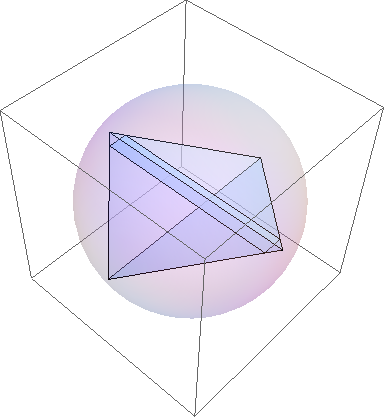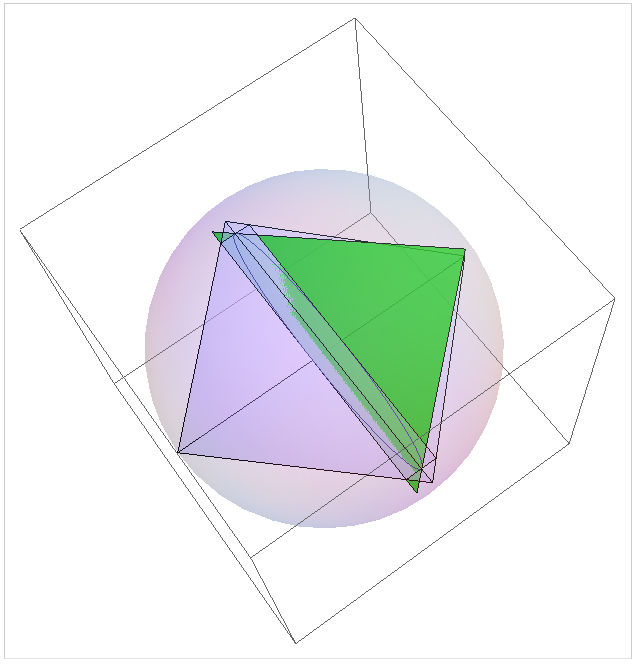Here is a bit of Mathematica code that rather supports Joseph's conclusion.
Tet[phi_] := {{Sin[phi], 0, Cos[phi]}, {-Sin[phi], 0, Cos[phi]}, {0, Sin[phi], -Cos[phi]}, {0, -Sin[phi], -Cos[phi]}};
Rect[a_, phi_] := Module[{x, y, u, w}, {x, y, u, w} = Tet[phi]; Polygon[{a x + (1 - a) u, a x + (1 - a) w, a y + (1 - a) w, a y + (1 - a) u}]];
v = Subsets[Range[4], {3}];
Manipulate[ Graphics3D[{Opacity[0.2], Sphere[{0, 0, 0}, 1], Opacity[0.3], GraphicsComplex[Tet[phi], Polygon[v]], Opacity[0.8], Rect[a, phi]}], {phi, 0, Pi/2}, {a, 0, 1}]
Using parameters like a=0.9, phi=1.4 one obtains an elongated rectangle inscribed a flat tetrahedron, close to an equatorial plane. The maximal inscribed ellipse in this rectangle hardly is contained in any triangle that fits in the unit ball.

Edit (2):
The following improved version uses an analytic solution for tetrahedra $ABCD$ with $[AB]$ perpendicular to $[CD]$, and the maximal ellipse $E$ in a plane cutting $ABCD$ parallel to $[AB]$ and $[CD]$. In this case the maximal distance of the vertices of the smallest enclosing triangle $T'$ from the origin is $1 - 2 (1 - a) a (1 + \cos(\phi - \psi)\leq 1$, where $A=(\sin \phi, 0, \cos\phi)$, , $B=(-\sin \phi, 0, \cos\phi)$ , $C={0, \sin \psi, -\cos\psi)$, $D=(0, - \sin \psi, -\cos\psi)$. Thus in all these cases in fact, $T' \subset B$.
I even think that all other (nontrivial) cases of $E\subset T$ can be reduced to one of those by aligning two edges of $T$ to lie along the main axes of $E$, while keeping $E$ inside. But this I cannot prove yet.
Code:
Tet[phi_, psi_] := {{Sin[phi], 0, Cos[phi]}, {-Sin[phi], 0, Cos[phi]}, {0, Sin[psi], -Cos[psi]}, {0, -Sin[psi], -Cos[psi]}}; Rect[a_, phi_, psi_] := Module[{x, y, u, w}, {x, y, u, w} = Tet[phi, psi]; Polygon[{a x + (1 - a) u, a x + (1 - a) w, a y + (1 - a) w, a y + (1 - a) u}]]; v = Subsets[Range[4], {3}]; ParPl[a_, phi_, psi_] := ParametricPlot3D[{a Sin[phi] Cos[t], -(-1 + a) Sin[psi] Sin[t], a Cos[phi] + (-1 + a) Cos[psi]}, {t, 0, 2 Pi}, Boxed -> False, Axes -> False]; Tangent[a_, phi_, psi_, t_, lam_] := {a Sin[phi] Cos[t], -(-1 + a) Sin[psi] Sin[t], a Cos[phi] + (-1 + a) Cos[psi]} + lam {-a Sin[phi] Sin[t], (1 - a) Cos[t] Sin[psi], 0};
Manipulate[ bt = 2 ArcTan[ 1 - (a Csc[psi] Sin[phi])/(-1 + a) - Sqrt[( a Csc[psi] Sin[phi] (2 - 2 a + a Csc[psi] Sin[phi]))/(-1 + a)^2]]; p1 = Tangent[a, phi, psi, bt, Cot[bt]]; p2 = Tangent[a, phi, psi, bt, -Sec[bt] - Tan[bt]]; p3 = {-1, 1, 1}*p2; Show[Graphics3D[{Opacity[0.2], Sphere[{0, 0, 0}, 1], Opacity[0.3], GraphicsComplex[Tet[phi, psi], Polygon[v]], Opacity[0.8], Rect[a, phi, psi], Green, Polygon[{p1, p2, p3}]}], ParPl[a, phi, psi]], {{phi, Pi/4}, 0, Pi/2}, {{psi, Pi/4}, 0, Pi}, {{a, 0.7}, 0, 1}]

